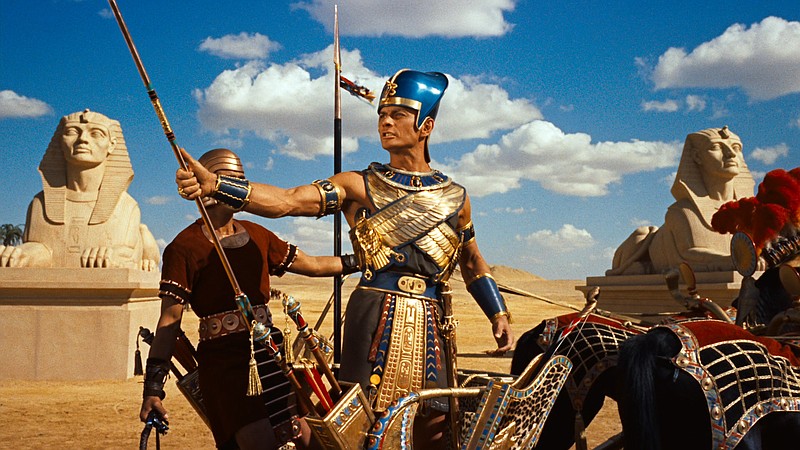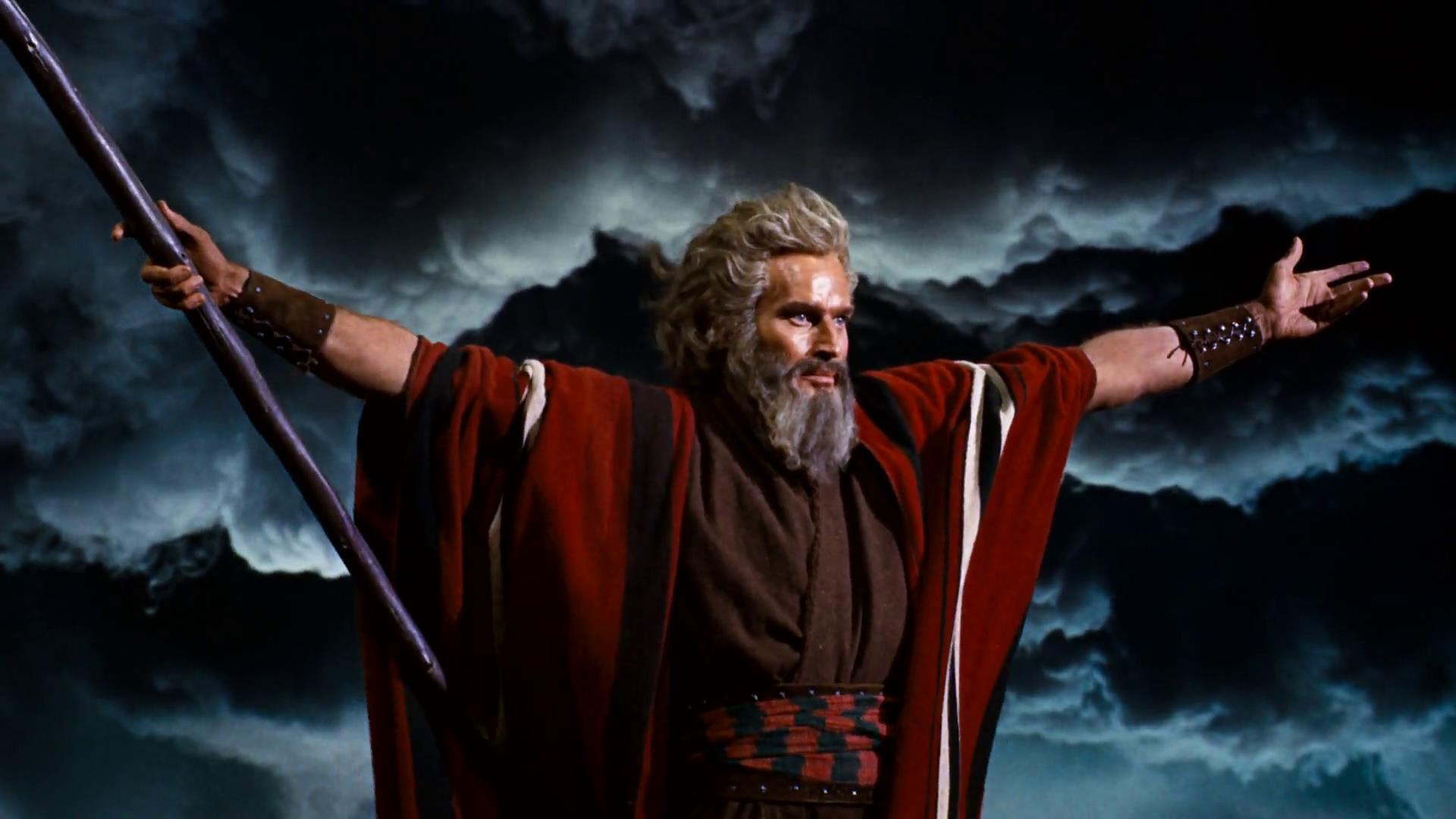Still the definitive depiction of the Exodus in the popular imagination.
About “The Ten Commandments”
› Summary: Moses, an Egyptian prince, discovers that he is the descendant of the enslaved Hebrew people. Abandoning court life, he accepts his God-given fate to free his people and lead them to the Promised Land.› Starring: Charlton Heston (Moses), Yul Brynner (Rameses), Anne Baxter (Nefretiri), Edward G. Robinson (Dathan), Yvonne De Carlo (Sephora), Debra Paget (Lilia) and John Derek (Joshua)› Director: Cecil B. DeMille› Release date: Oct. 5, 1956› Runtime: 220 minutes (3 hours 40 minutes)› Budget: $13.2 million ($115 million, adjusted for inflation)› Box-office take on initial theatrical run: $120 million ($1.05 billion, adjusted for inflation)
The annual broadcast
Watch “The Ten Commandments” tonight at 7 on ABC (Comcast channels 10 and 431; EPB channels 9 and 309).
Moses spent 40 years leading the Israelites through the wilderness on a quest to find the Promised Land. For half again as long, however, Hollywood's depiction of that journey in "The Ten Commandments" has endured as one of Hollywood's most beloved faith-based films.
On Oct. 5, director Cecil B. DeMille's epic will celebrate its 60th anniversary and, in a decades-long Easter weekend tradition, ABC will broadcast the film tonight at 7.
In its issue published Nov. 12, 1956, Life magazine described "The Ten Commandments" as a "gigantean series of spectacles a high climax to the career of Cecil DeMille." Local pastors argue, however, that the reason the film has remained popular for so long has more to do with its adherence to Scripture than with its special effects, titanic set pieces or leading man Charlton Heston's memorable turn as Moses.
"What I appreciate about it is that they didn't try to amend the biblical story; they just told it," says Ron Phillips, senior pastor at Abba's House in Hixson. "I think people like reality; they like it told that way."
Phillips, 68, entered the ministry when he was 19, a few years after he first saw "The Ten Commandments." His first assignment was leading a congregation in rural Alabama and, in those days, going to movies - even biblical ones - was frowned upon in the Baptist community, he says. If he and his wife wanted to see a film, they drove to Montgomery or Birmingham to evade prying eyes and wagging tongues.
"We didn't want to do anything around our little town because we didn't want anyone to see us," he laughs. "We didn't think it was wrong, but it wasn't acceptable back then."
At the time, Phillips says, the majority of faith-based films were "not very good and were kinda cheesy." Movies like "The Ten Commandments," "Ben-Hur" and "The Greatest Story Ever Told," he says, were exceptions that began to raise the narrative bar and better demonstrate the power of film to spread evangelical messages.
"['The Ten Commandments'] doesn't look that great today, but back then, it was quite a scene," Phillips says. "And, of course, who can forget Charlton Heston? He'll always be Moses to me."
Many fans point to Heston's performance as well as the epic scope and the then-revolutionary visuals as the most memorable characteristics of "The Ten Commandments."
Reviewers and fans alike say one of the movie's most iconic scenes arrives just over halfway through its nearly four-hour run time. Heston - then just 33 years old but depicted with artificially grayed hair and beard - stands determinedly on a rocky crest overlooking the Red Sea. Spreading his arms wide underneath stormy skies, the waters surge to either side.
The scene depicting the parting of the Red Sea stood out to the late film critic Roger Ebert so strongly, it made his 1995 list of 100 Great Movie Moments.
Timeless
Even though reviewers have held it in high esteem for decades, critics seeing "The Ten Commandments" during its initial release were glowing with praise, especially for its graphical splendor, which earned it the Academy Award for Best Special Effects in 1957.
"'The Ten Commandments' was a dream in the mind of Cecil B. DeMille beyond what anyone else had ever projected, and he has brought it off," Hollywood Reporter's James Powers wrote in a 1956 review. "[The film] is, in that misused but here accurate word, unique. There is no other picture like it. There will be none. If it could be summed up in a word, the word would be sublime."
For 28-year-old nurse Rachael Smith, watching "The Ten Commandments" on TV has been an Easter tradition since she was 8 years old. Like "Gone With the Wind," the Chickamauga, Ga., resident says, it's a story whose impact hasn't dulled with age.
"It will never get old," she says. "Stories like that are timeless. There is just something about the way they make you feel as you watch them that will never make people tire of them.
"[The first time I watched it] I remember feeling proud afterward - proud to be a Christian and to know that the events in the movie weren't just something created by Hollywood but something that was part of an actual history."
"The Ten Commandments" wasn't just timeless, it also was hugely successful. Box Office Mojo lists it as the sixth highest-earning film ever, adjusting ticket prices for inflation. During its initial run at the box office, it earned $120 million and more than half, $68 million, was in domestic theaters, according to the Internet Movie Database.
Burning bushes and double-edged swords
That the story of Moses should resonate so well with Americans, in particular, isn't that surprising, says the Rev. Mark Flynn, Christ United Methodist senior pastor.
"It translates better to our culture," he says. "At the end of the movie we want resolution, and the resolution has to be unambiguous. We like movies where a clear-cut hero saves the day and the bad guys, the black hats, are punished.
"In the end, what ['The Ten Commandments'] draws people to is the sense that God is active. Maybe that's why people prefer it at this time of year. It shows God active in the world. It shows a God who cares, who's watching and who is concerned about where we're oppressed and where evil is flourishing. That is a powerful message and a message that is relevant to Easter."
That the film has become so iconic, however, is a bit of a double-edged sword, he says. Yes, films such as "The Ten Commandments" help expose modern viewers - many of whom Flynn describes as a "biblically illiterate" - to stories that used to be more widely known, but the persuasive power of those images also can make them hard to look past when it comes to personally interpreting Scripture, he says.
"I always tell people to be careful what you watch because once you watch 'The Passion of the Christ,' for instance, it's hard not to have those images pass through your mind when you read about the Crucifixion," Flynn says. "Once you watch 'The Ten Commandments,' you'll think that Moses looked like Charlton Heston.
"In that sense, I would say movies are harmful in that it provides such a strong filter - we're such a visual people now - that it may be hard to set those aside and hear the words afresh."
Contact Casey Phillips at cphillips@timesfreepress.com or 423-757-6205. Follow him on Twitter at @PhillipsCTFP.
Awards and honors
* Academy Awards — Won for Best Special Effects, nominated for Best Picture, Color Cinematography, Color Art Direction-Set Decoration, Color Costume Design, Sound Recording and Film Editing* Golden Globes — Charlton Heston nominated for Best Actor in a Drama* Added to the National Film Preservation Board’s National Film Registry in 1999* No. 79 on the American Film Institute’s list of the Top 100 Most Inspiring Films of all Time; Moses listed at No. 43 on the AFI list of Top 50 Greatest Heroes & Villains
Did you know?
* “The Ten Commandments” director Cecil B. DeMille was one of three founders in 1913 of the Lasky Film Co., which later became Paramount Pictures. He was also one of 36 co-founders of the Academy of Motion Picture Arts and Sciences.* According to Life magazine, at the time of its release, “The Ten Commandments” was “the longest, most costly, most monumental movie in the history of moviemaking.”* Charlton Heston’s performance may be the most iconic depiction of Moses on the big screen, but other actors to portray the liberator of the Jews include Christian Bale (“Exodus: Gods and Kings”), Mel Brooks (“History of the World: Part I”), Ben Kingsley (“Moses”), Christian Slater (“The Ten Commandments,” animated 2007) and Val Kilmer (“The Ten Commandments: The Musical”).* “The Ten Commandments” was DeMille’s final directorial project, but it wasn’t his first biblical adaptation. He previously directed 1949’s “Samson and Delilah,” 1927’s “King of Kings” and an earlier version of “The Ten Commandments” that was released in 1923.* Director Alfred Hitchcock’s daughter, Patricia, had an uncredited role as an extra in “The Ten Commandments.” Four years later, she received near-top billing in her father’s film “Psycho.”* The film’s narration features DeMille’s voice.* In addition to shooting in Egypt — including at the biblically significant Mount Sinai — “The Ten Commandments” was filmed on location in Arizona’s Monument Valley and California’s Red Rock Canyon State Park.* “The Ten Commandments” composer Elmer Bernstein also scored “The Magnificent Seven,” “To Kill a Mockingbird,” “Cape Fear,” “Ghostbusters,” “Airplane!” and “The Blues Brothers.”* The scene depicting the Israelites’ exodus features about 15,000 extras and more than 10,000 animals. In all, Variety magazine reported in 1955, the film employed more than 25,000 extras.* While filming on location in Egypt, DeMille suffered a heart attack when climbing more than 120 feet to check on a faulty camera mounted atop a gate. He continued filming two days later against doctor’s orders.
The Bible on the big screen, an abridged timeline
1923: “The Ten Commandments”1949: “Samson and Delilah”1951: “David and Bathsheba”1953: “The Robe”1959: “Ben-Hur”1961: “King of Kings”1962: “Sodom and Gomorrah”1965: “The Greatest Story Ever Told”1966: “The Bible: In the Beginning”1985: “King David”1993: “Abraham”1998: “The Prince of Egypt”1999: “Esther”2004: “The Passion of the Christ”2006: “The Nativity Story”2009: “The Book of Ruth: Journey of Faith”2014: “Noah”; “Son of God”; “Exodus: Gods and Kings”2016: “The Young Messiah”; “Risen”

